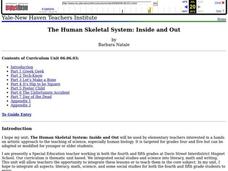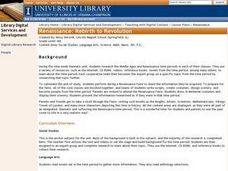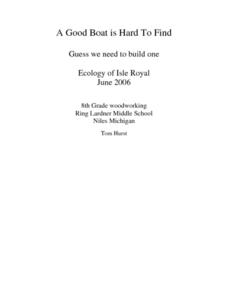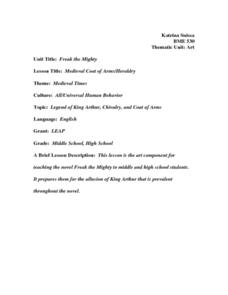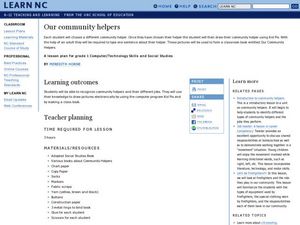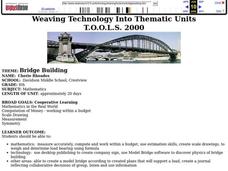Curated OER
Shake, Rattle and Erupt
Students study myths regarding four earthquakes myths. They receive a list of supplies each family should have at home to prepare for an earthquake and construct an "Earthquake Preparation" poster showing some of the most important items...
Curated OER
Lesson Plans for the Novel "Jurassic Park"
High schoolers read the book, Jurassic Park, then answer questions.
Curated OER
The Human Skeletal System: Inside and Out
Students investigate the body. In this biology lesson plan, students will learn the basics of the bones in their body and about how they can be injured. Students will participate in a total of seven activities designed to improve their...
Curated OER
Deserts Around the World
Second graders explore the deserts around the world. They use a map and locate America on the map. Students discuss and identify the characteristics of deserts and differentiate the meanings of the word desert and dessert. Students...
Smithsonian Institution
Dia de los Muertos: Honoring our Ancestors Through Community Celebration
Oral storytelling has been an important part of every culture. The time-honored practice uses stories as a conduit for a culture's values and customs from one generation to the next. Keep the tradition going with a family interview...
Curated OER
Alfonso Ball
Joey Alphonso made up this game, which is played using a gator skin ball and a tennis racket on a basketball court. The simple rules and strategy of the game are explained. This is a high-scoring, run around activity. Everyone can...
Curated OER
Exploration of "Pillbugs"
Fifth graders define vocabulary terms, identify the characteristics of a pillbug, and create a dichotomous key. Then they examine the pillbugs and make observations and record these observations. Finally, 5th graders observe specific...
Curated OER
Ants
Learners make sequential patterns by using ants and following the model. They identify different parts of an ant by matching the picture to the word name. Pupils identify the ant's life cycle by creating a chart using pictures.
Curated OER
Renaissance: Rebirth to Revolution
Sixth graders use a variety of resources to research the Middle Ages and Renaissance over a nine-week period. Working in cooperative teams, they become experts on specific topics. Students hold a Renaissance Faire and role-play as...
Curated OER
A Good Boat is Hard To Find
Eighth graders design and construct a safe and efficient human powered watercraft that can be used on a trip on the Great Lakes. Students utilize math and measurement skills to design and cut the pieces for their boat. Working in...
Curated OER
Soaring High with Kites
Learners make kites from patterns. They write haiku poetry. They listen to stories about kite festivals in different countries.
Curated OER
Medieval Coat of Arms/Heraldry
Students examine the history of Heraldry from medieval times in preparation for reading the novel "Freak the Mighty." They view and discuss examples of shields and discuss the color system and how shields were divided. As a culminating...
Curated OER
Gingerbread Baby v. Gingerbread Boy #7
Students read two stories. In this comparison lesson, students read "The Gingerbread Baby," by Jan Brett and the original "Gingerbread Boy." Students use a Venn Diagram to compare and contrast the two stories.
Curated OER
Classroom Guide for the Redwall Series
Students participate in cross-curricular activities and readings to become familiar with the works of Brian Jacques. In this heroes lesson, students discuss the character traits of legends and how their characters develop through events...
Curated OER
The Island of The Blue Eagles
Sixth graders read the book CALL IT COURAGE by Armstrong Sperry. They use the Internet to research and work in groups to write ocean chants. They construct dioramas and build a sea turtle withK'NEX.
Curated OER
Publishing With Photos!
Students create books with photographs as illustrations. In this book making lesson, students create books for different subjects to accompany what they are learning. They take photographs to match what they have written.
Curated OER
"Our Community Helpers"
Young scholars define the term community. They list many, varied, and unusual jobs (careers) that people might have in our Communities. Students identify the purpose of the work done by their parents-either in the home, or outside of the...
Curated OER
Transportation
Students explore basic transportation vehicles, specifically air, land, and water vehicles, name six different modes of transportation, identify four different kinds of train cars, and three differences between two different modes of...
Curated OER
Bridge Building
Eighth graders will create model drawings of bridges and integrate technology into the process of creating a visual representation. Technology is used in the industry of design and architecture. This lesson helps to build real life skills.
Curated OER
Note Taking
Second graders work in groups to gather information from a factual paragraph on the topic of ants. They demonstrate taking notes by selecting 3 or 4 important key words in each sentence and write it on a note card to compile summary...
Curated OER
PowerPoint Homophones
Student identify homophones. Students, in pairs, work together to create a PowerPoint presentation using pictures to show the difference between the words. The PowerPoint can then be used by all the students in lower grade levels.
Curated OER
The Circus Train
Students study the safety message "Stay Back from tracks and trains!" students count animals and train cars, and repeat The Circus Train poem
Curated OER
Recycling
Students investigate how to reduce, recycle, and reuse items in order to conserve natural resources. They complete a trash graphing activity after discussing different types of trash. Finally, the examine ways to buy recycled products to...
Curated OER
The Progressive Era: Muckrakers Grade 8
As you explore an excerpt from Upton Sinclair's The Jungle with your class, discuss how his descriptions of the meat-packing industry caught the public's attention and helped to promote change in the Progressive Era.




